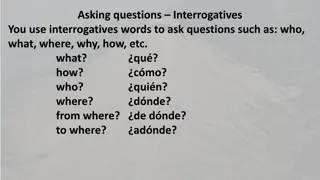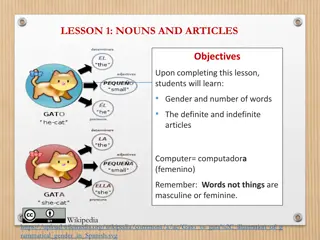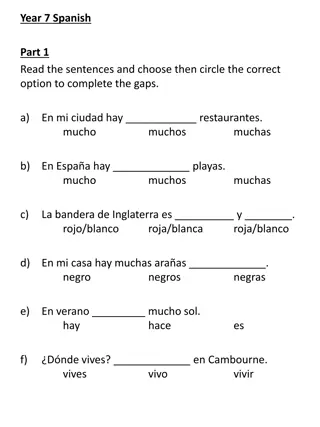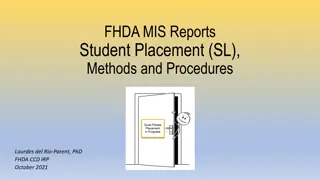Pronoun Placement Rules in Spanish Sentences
Clear up confusion around the placement of reflexive, direct object, and indirect object pronouns in Spanish sentences and commands. Learn the placement rules for different types of pronouns in statements and commands, including examples for single-verb and two-verb sentences. Understand the order of pronouns in sentences with multiple pronouns and discover the rules for affirmative and negative commands with pronouns in Spanish.
Download Presentation

Please find below an Image/Link to download the presentation.
The content on the website is provided AS IS for your information and personal use only. It may not be sold, licensed, or shared on other websites without obtaining consent from the author.If you encounter any issues during the download, it is possible that the publisher has removed the file from their server.
You are allowed to download the files provided on this website for personal or commercial use, subject to the condition that they are used lawfully. All files are the property of their respective owners.
The content on the website is provided AS IS for your information and personal use only. It may not be sold, licensed, or shared on other websites without obtaining consent from the author.
E N D
Presentation Transcript
PRONOUN PLACEMENT Honors espa ol 3 - Mendoza
Pronoun Placement Lets clear up the confusion There seems to be confusion about where reflexive, direct object, and indirect object pronouns are placed in sentences and in commands. Here is a quick review: All 3 of these types of pronouns follow the exact same placement rules. Here are the rules:
Pronoun Placement Lets clear up the confusion Statement rules In a statement where there is only 1 verb, there is only 1 choice of placement. This placement is BEFORE the conjugated verb. Example: She buys them (referring to los zapatos) = Ella los compra. (DOP) They told me. = Ellos me dijeron. (IOP) We wash (self) = Nosotros nos lavamos. (Reflexive)
Pronoun Placement 2 verbs In a statement where there are 2 verbs, you have 2 choices on where to place the pronoun. They are eating it (referring to la pizza) = Ellos la est n comiendo OR Ellos est n comi ndola (DOP) I want to give him the gift. = Yo quiero darle el regalo. OR Yo le quiero dar el regalo. (IOP) He wants to take a shower. = l quiere ducharse OR l se quiere duchar. (Reflexive) ****NOTE: When there is a reflexive, IOP, & DOP all in one sentence, the order of the pronouns is always the same = RID******
Pronoun placement - commands OK, lets talk about commands and pronoun placement: A command is when you are telling a person what to do or what not to do, different than a statement, which is simply a sentence stating a fact. Example She eats it (statement) Eat it! (affirmative command) Don t eat it! (negative command)
Pronoun placement - commands Command rules Pronoun placement with commands, depends on whether the command is an affirmative command (telling someone what to do) or a negative command (telling a person what NOT to do. Affirmative commands with pronouns In an affirmative command, the pronoun is ATTACHED to the end of the command. Example: Give us the pizza. = D nos la pizza. (IOP) If there are two ore more pronouns in the command, we still use the order RID Give it to us (referring to the pizza) (DOP & IOP) = D nosla
Pronoun placement - commands Negative commands with pronouns In a negative command, the pronoun(s) go BEFORE the verb Don t buy them the pizza. = No les compra (t command) No les compre (ud command) la pizza. (IOP) If there are two r more pronouns in the command, we still use the order RID Don t buy it (referring to the pizza) for us = No nos la compra (t command)/ No nos la compre (Ud command)
Reflexive pronouns (lavarse) me nos te os se se
Direct object pronouns (DOPs) me nos te os lo/la los/las
Indirect object pronouns (IOPs) me nos te os le les

 undefined
undefined






























